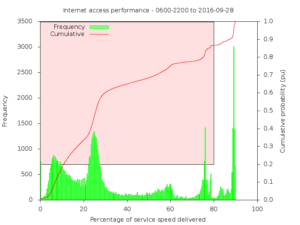We have had wired broadband service delivered to these premises for almost ten years, supplied by five vendors: Telstra Bigpond, iiNet, Amaysim, Southern Phone and now Exetel.
Download speed
Download speed is an important performance characteristic, and fairly quantifying it is a challenge.
If I were to express my service expectation as “I want it to deliver most of the rated speed, most of the time during the hours that I want to use it” we can express that by better defining the three terms:
- most of the rated speed;
- most of the time; and
- the hours that I want to use it.
Most of the rated speed
Let’s consider that most means 80%, so the critical value of speed is 80% of the rated speed, eg 80% of 12Mb/s is 9.6Mb/s.
Most of the time
Let’s consider that most means 80%, so the critical value is 80% of the time.
During the hours that I want to use it
I sleep at nights, and use the Internet variously during the day, the most important times for service to be adequate are from 06:00 to 20:00.
Critical speed requirement
Capturing the foregoing, I could write “Download speed must exceed 80% of the rated speed, 80% of the time between the hours of 06:00 and 20:00” each week.
This is known as a Service Level specification.
Statistically, this is stated as the 20 percentile speed measured between 06:00 and 22:00 over a week must be greater than 80% of the rated speed.
Test results
A realistic simple HTTP download is scheduled every half hour, and the effective download speed is recorded. This data has been gathered for many years.
Over the nearly 10 years of service, the rated speed has varied, 8, 12, and 50Mb/s at different times. To compare these, the speed in any one observation needs to be normalised to the applicable rated speed, so for this purpose speed is calculated as a percentage of the applicable rated speed.
Telstra
Above is a plot of the measured speed over a period of many years. Continue reading Yet another change of Internet broadband access



